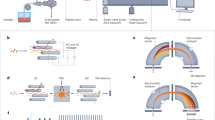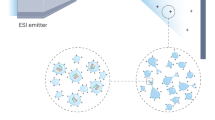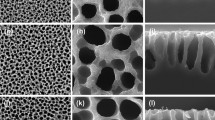Abstract
Desorption mass spectrometry has undergone significant improvements since the original experiments were performed more than 90 years ago1. The most dramatic change occurred in the early1980s with the introduction of an organic matrix2,3,4 to transfer energy to the analyte. This reduces ion fragmentation but also introduces background ions from the matrix. Here we describe a matrix-free strategy forbiomolecular mass spectrometry based on pulsed-laser desorption–ionization from a porous silicon5 surface. Our method uses porous silicon to trap analytes deposited on the surface, and laser irradiation to vaporize and ionize them. We show that the method works at femtomole and attomole levels of analyte, and induces little or no fragmentation, in contrast to what is typically observed with other such approaches6,7,8,9,10,11. The ability to perform these measurements without a matrix3,4,12,13 also makes itmore amenable to small-molecule analysis. Chemical14 and structural15 modification of the porous silicon has enabled optimization of the ionization characteristics of the surface. Our technique offers good sensitivity as well as compatibility with silicon-based microfluidics and microchip technologies.
This is a preview of subscription content, access via your institution
Access options
Subscribe to this journal
Receive 51 print issues and online access
$199.00 per year
only $3.90 per issue
Buy this article
- Purchase on Springer Link
- Instant access to full article PDF
Prices may be subject to local taxes which are calculated during checkout




Similar content being viewed by others
References
Thomson, J. J. Rays of positive electricity. Phil. Mag. 20, 752–767 (1910).
Liu, L. K., Busch, K. L. & Cooks, R. G. Matrix-assisted secondary ion mass spectra of biological compounds. Anal. Chem. 53, 109–113 (1981).
Barber, M., Bordoli, R. S., Sedgwick, R. D. & Tyler, A. N. Fast-atom bombardment of solids as an ion source in mass spectroscopy. Nature 293, 270–275 (1981).
Karas, M. & Hillenkamp, F. Laser desorption ionization of proteins with molecular mass exceeding 10,000 daltons Anal. Chem. 60, 2299–2301 (1988).
Canham, L. T. Silicon quantum wire array fabrication by electrochemical and chemical dissolution of wafers. Appl. Phys. Lett. 57, 1046–1048 (1990).
Zenobi, R. Laser-assisted mass spectrometry. Chimia 51, 801–803 (1997).
Zhan, Q., Wright, S. J. & Zenobi, R. Laser desorption substrate effects. J. Am. Soc. Mass Spectr. 8, 525–531 (1997).
Hrubowchak, D. M., Ervin, M. H., Wood, M. C. & Winograd, N. Detection of biomolecules on surfaces using ion-beam-induced desorption and multiphoton resonance ionization. Anal. Chem. 63, 1947–1953 (1991).
Varakin, V. N., Lunchev, V. A. & Simonov, A. P. Ultraviolet-laser chemistry of adsorbed dimethylcadmium molecules. High En. Chem. 28, 406–411 (1994).
Wang, S. L., Ledingham, K. W. D., Jia, W. J. & Singhal, R. P. Studies of silicon nitride (Si3N4) using laser ablation mass spectrometry. Appl. Surf. Sci. 93, 205–210 (1996).
Posthumus, M. A., Kistemaker, P. G., Meuzelaar, H. L. C. & Ten Noever de Brauw, M. C. Laser desorption–mass spectrometry of polar nonvolatile bio-organic molecules. Anal. Chem. 50, 985–991 (1978).
Macfarlane, R. D. & Torgerson, D. F. Californium-252 plasma desorption mass spectroscopy. Science 191, 920–925 (1976).
Siuzdak, G. in Mass Spectrometry for Biotechnology 162 (Academic, San Diego, (1996).
Buriak, J. M. & Allen, M. J. Lewis acid mediated functionalization of porous silicon with substituted alkenes and alkynes. J. Am. Chem. Soc. 120, 1339–1340 (1998).
Cullis, A. G., Canham, L. T. & Calcott, P. D. J. The structural and luminescence properties of porous silicon. J. Appl. Phys. 82, 909–965 (1997).
Hillenkamp, F., Karas, M., Beavis, R. C. & Chait, B. T. Matrix-assisted laser desorption ionization mass spectrometry of biopolymers. Anal. Chem. 63, A1193–A1202 (1991).
Benninghoven, A., Rüdenauer, F. G. & Werner, H. W. (eds) Secondary Ion Mass Spectrometry 1227 (Wiley, New York, (1987).
Amato, G. & Rosenbauer, M. in Optoelectronic Properties of Semiconductors and Superlattices (eds Amato, G., Delerue, C. & Bardeleben, H.-J.v.) 3–52 (Gordon and Breach, Amsterdam, (1997).
Sailor, M. J. & Lee, E. J. Surface chemistry of luminescent silicon nanocrystallites. Adv. Mater. 9, 783–793 (1997).
Stewart, M. P. & Buriak, J. M. Photopatterned hydrosilylation on porous silicon. Angew. Chem. Int. Edn 37, 3257–3261 (1998).
Doan, V. V. & Sailor, M. J. Photolithographic fabrication of micron-dimension porous Si structures exhibiting visible luminescence. Appl. Phys. Lett. 60, 619–620 (1992).
Lidgard, R. & Duncan, M. W. Utility of matrix-assisted laser desorption ionization time-of-flight mass spectrometry for the analysis of low molecular weight compounds. Rapid Commun. Mass Spectr. 9, 128–132 (1995).
Knochenmuss, R., Dubois, F., Dale, M. J. & Zenobi, R. The matrix suppression effect and ionization mechanisms in matrix-assisted laser desorption/ionization. Rapid Commun. Mass Spectr. 10, 871–877 (1996).
Canham, L. T. in Properties of Porous Silicon (ed. Canham, L. T.) 83–88 (Institution of Electrical Engineers, London, (1997).
Hérino, R. in Properties of Porous Silicon (ed. Canham, L. T.) 89–96 (Institution of Electrical Engineers, London, (1997).
Ogata, Y. H., Kato, F., Tsuboi, T. & Sakka, T. J. Changes in the environment of hydrogen in porous silicon with thermal annealing. Electrochem. Soc. 145, 2439–2444 (1998).
Canham, L. T. in Properties of Porous Silicon (ed. Canham, L. T.) 154–157 (Institution of Electrical Engineers, London, (1997).
Canham, L. T. in Properties of Porous Silicon (ed. Canham, L. T.) 44–50 (Institution of Electrical Engineers, London, (1997).
O'Donnell, M. J., Tang, K., Koster, H. & Smith, C. L. High density, covalent attachment of DNA to silicon wafers for analysis by MALDI-TOF mass spectrometry. Anal. Chem. 69, 2438–2443 (1997).
Schmuki, P., Erickson, L. E. & Lockwood, D. J. Light emitting micropatterns of porous Si created at surface defects. Phys. Rev. Lett. 80, 4060–4063 (1998).
Acknowledgements
We thank J. Boydston, Z. Shen, R. G. Cooks and M. Duncan for their comments, T.Hollenbeck for suggesting the acronym DIOS, K. Harris for his initial analyses of porous silicon surfaces, and M. P. Stewart and T. Geders for preparing oxidized and p-type porous silicon samples. G.S. is grateful for partial funding by an NIH grant; J.M.B. thanks Purdue University for support and the Camille and Henry Dreyfus Foundation for a New Faculty Award.
Author information
Authors and Affiliations
Corresponding author
Rights and permissions
About this article
Cite this article
Wei, J., Buriak, J. & Siuzdak, G. Desorption–ionization mass spectrometry on porous silicon. Nature 399, 243–246 (1999). https://doi.org/10.1038/20400
Received:
Accepted:
Issue Date:
DOI: https://doi.org/10.1038/20400
This article is cited by
-
Plasmonic polydopamine-modified TiO2 nanotube substrates for surface-assisted laser desorption/ionization mass spectrometry imaging
Nano Research (2023)
-
Quantitative analysis of vitamin D using m/MALDI-TOF mass spectrometry based on a parylene matrix chip
Journal of Analytical Science and Technology (2022)
-
Laser-induced electron transfer desorption/ionization on MoO3 and WO3 surfaces for the determination of dithiocarbamates
Analytical and Bioanalytical Chemistry (2022)
-
Recent Advances in Surface-Assisted Laser Desorption/Ionization Mass Spectrometry and Its Imaging for Small Molecules
Journal of Analysis and Testing (2022)
-
Multiplexed nanomaterial-assisted laser desorption/ionization for pan-cancer diagnosis and classification
Nature Communications (2022)
Comments
By submitting a comment you agree to abide by our Terms and Community Guidelines. If you find something abusive or that does not comply with our terms or guidelines please flag it as inappropriate.



